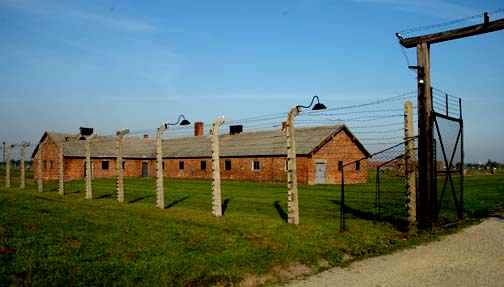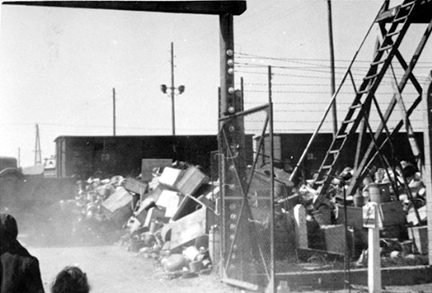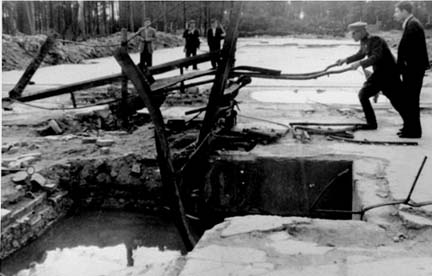|
Zyklon-B was used at Auschwitz-Birkenau for gassing the Jews, and it was also used to disinfect the clothing of the prisoners in an attempt to prevent typhus which is spread by body lice. The German word for a room where clothing was disinfected with Zyklon-B was Gaskammer, the same term that is used by German-speaking Holocaust historians today to mean a homicidal gas chamber.  The photo above shows one of the Disinfection buildings that has a Gaskammer inside. The gate on the right is the entrance into the women's barracks sections B1a and B1b from the road that bisects the entire camp from north to south, going from here all the way to the Mexico section on the north side of the camp. As of October 2005, the disinfection buildings were not open to the public, and there was no tourist information display board. In spite of all the effort to prevent typhus, there were two serious epidemics, one in the Summer of 1942 and another in the Summer of 1943. On July 23, 1942, Commandant Hoess ordered the whole Birkenau camp to be quarantined for fear that the epidemic would spread. On July 7, 1943, he again decreed that the Birkenau camp was off-limits to the German soldiers who were the camp administrators. The gassing of the Jews continued even while the camp was quarantined because of typhus. Eventually, typhus spread to the concentration camps in Germany in December 1944 and this caused many deaths in the last months of the war, particularly in the Bergen-Belsen camp where 35,000 prisoners died in only two months time. Half of all the deaths in the Dachau concentration camp were in the last six months of the war when a typhus epidemic was out of control there. One method that was used to end the typhus epidemics at Auschwitz-Birkenau was the gassing of the sick prisoners. On August 29, 1942, there were 746 prisoners from the Birkenau camp hospital who were gassed. In 1981, the West German Prosecutor's Office issued a warrant for the arrest of Dr. Josef Mengele for his crime of sending 507 Gypsy men and 528 Gypsy women to the gas chamber on May 25, 1943 because they were suspected of being infected with typhus. Dr. Mengele had died in 1979 in Brazil, but his death was kept a secret. The prisoners considered the hospital to be the anteroom of the gas chamber; the fear of being gassed kept many of them from going to the infirmary which caused even more deaths. After visiting the factory site at the Auschwitz III camp, also known as Monowitz, on July 17 and 18, 1942, Reichsführer-SS Heinrich Himmler witnessed the gassing of Jews in the little white house, according to Laurence Rees, the author of "Auschwitz, a New History." The next day, on July 19th, Himmler ordered that the "resettlement" of the entire Jewish population of occupied Poland be completed by December 31, 1942. According to Rees, "resettlement" was a Nazi euphemism for murder. At that time, Auschwitz-Birkenau was not yet equipped to be a death factory, having only the two old farm houses that were being used as gas chambers. Himmler's order for the deportation and genocide of the Jews was made even before the means of systematic killing was in place. The Jews were told that they were going to be resettled in the East and they were encouraged to bring all their valuables with them to the Auschwitz camp. Their luggage was confiscated as soon as they arrived and all their possessions were taken from them. Their clothing was disinfected in the steam chambers in the Sauna or in a disinfection Gaskammer.  Holocaust survivor Ann Feig Rosenheck was 13 years old in 1944 when the Hungarian Jews in her town were sent first to a ghetto and then to the death camp at Birkenau, where 92 members of her family were killed. Rosenheck spoke to an 8th grade English class at Kate Collins Middle School in Waynesboro, VA in 2008; she told the students that she herself narrowly escaped death in the gas chamber. Rosenheck survived because on the day that she was taken to the crematorium to be gassed, the building was locked. Rosenheck was sent instead to a munitions factory that was a sub-camp of Dachau. In April 1945, she was evacuated to the main Dachau camp where she was liberated by American troops on April 29, 1945. The gassing of the Jews at Birkenau stopped at the end of October 1944; the evacuation of the survivors to other concentration camps in the West had already begun in early October. Anne Frank and her sister Margo were on one of the first transports out of Auschwitz, which took them to Bergen-Belsen, where they both died of typhus. Auschwitz survivor Zev Kedem arrived at Birkenau on November 3, 1944, according to a talk that he gave to students at Colorado State University for Holocaust Awareness week in March 2008. Ten-year-old Kedem's name had been on "Schindler's List," and he had been among the 1,100 prisoners at the Plaszow camp who were sent to Oskar Schindler's factory in Brinlitz in what is now the Czech Republic. Less than a week after he arrived at Schindler's factory, Kedem and his father were sent to Auschwitz along with four other boys and their fathers because the boys were under 13 years of age and were too young to work in the factory. According to Kedem, the gas chambers had closed just the day before, on the orders of Adolf Hitler. Kedem survived a death march out of Auschwitz and a train ride from Germany to the Mauthausen concentration camp in Austria where he was sent to work in a factory in one of the Mauthausen sub-camps. According to the testimony of Rudolf Hoess at the Nuremberg International Military Tribunal, when he was a defense witness for Ernst Kaltenbrunner, the highest number of prisoners in the 425-acre Birkenau camp, at any one time, was 140,000. On any given day, there were between 500,000 and 700,000 prisoners in the entire Nazi camp system, according to the records kept on Hollerith punch cards, as noted by Edwin Black in his book "IBM and the Holocaust." On July 12, 1944, there were 92,705 prisoners in the whole Auschwitz camp complex, according to the roll call taken that day. In the main camp, there were 14,386 men. At Birkenau, there were 19,711 men and 31,406 women. There were 26,705 men in Auschwitz III. This total did not include the Hungarian Jews who were not registered, according to Danuta Czech. They were held in section B III of Birkenau, called Mexico, while they waited to be gassed or sent to another camp. On January 18, 1945, all three of the Auschwitz camps and the 40 satellite camps were abandoned by the Nazis. According to Danuta Czech, who wrote a book entitled "Auschwitz Kalendarium," the total count from the last roll call on January 17, 1945 was 67,012 prisoners in all three Auschwitz camps. According to Otto Frank, the father of Anne Frank, the prisoners were given a choice between staying in the camps until the Soviet troops arrived or going on a 50-kilometer death march through two feet of snow to the border of the old German Reich where they would be put on trains and taken to camps in Germany. Around sixty thousand prisoners chose to go with the Germans and many of them didn't survive the march. Those who couldn't keep up were shot and their bodies were left in the snow. Many more died on the trains taking them to Dachau, Buchenwald, Bergen-Belsen or Mauthausen. Otto Frank chose to stay in the camp and he survived. On January 20, 1945, the Germans came back to the camp to blow up the Krema II and Krema III buildings along with their underground gas chambers. Krema IV had already been blown up by the prisoners during a revolt in October 1944. On January 26, 1945, the Germans came back again to blow up Krema V. The next day, at 3 p.m. on January 27, 1945, Soviet soldiers of the First Army of the Ukrainian Front, commanded by Marshal Koniev, entered the Auschwitz and Birkenau camps, according to an Auschwitz Museum guidebook. However, a book entitled "The Complete Idiot's Guide to Nazi Germany," written by Robert Smith Thompson, and copyrighted in 2003, gives the startling information that the Soviet army crossed the Vistula river, near Auschwitz, on January 17, 1945. The following quote, regarding the Birkenau camp, is from page 310 of this book: "The Soviets almost immediately dynamited the gas chambers." No explanation was given by the author as to why the Soviets would want to destroy the evidence of the gassing of the Jews at Birkenau.   According to Lawrence Rees, who wrote "Auschwitz - a New History," there were approximately 6,500 SS staff members who worked at Auschwitz-Birkenau, and only 750 ever received punishment of any kind. The Western Allies (Great Britain, France and the United States) did not have jurisdiction over the war criminals at Auschwitz-Birkenau because the camp was liberated by the Soviet Union. Only the staff members who were transferred to Bergen-Belsen came under the jurisdiction of the British, and those who were transferred to Dachau, Buchenwald, Nordhausen or Mauthausen came under the jurisdiction of the American military. After the war, Poland became a Communist country under the domination of the Soviet Union and the prosecution of the SS men who worked in what is now Poland was turned over to the Polish government. Only 789 members of the Auschwitz staff ever faced justice, according to Lawrence Rees, and 673 of them were tried in Polish courts. During the Nuremberg IMT, the SS was designated as a "criminal organization," which meant that every member of the SS was automatically a war criminal, even the members of the Waffen-SS who fought in battle. However, Lawrence Rees wrote that "no attempt was ever made to enforce the view that the mere act of working in the SS at Auschwitz was a war crime." The American Military Tribunal at Dachau did try staff members of Dachau, Buchenwald, Nordhausen and Mauthausen on a charge of participating in a "common design" to commit war crimes merely because they were on the staff of a concentration camp, but this never happened with regard to the staff of Auschwitz; 85% of the staff members of Auschwitz, who survived the war, were never put on trial. Selection for the gas chamber or laborAuschwitz III - aka MonowitzMonowitz gas chamber?Liberation of Auschwitz-BirkenauSurvivors of Birkenau campDeath StatisticsHistory of AuschwitzAuschwitz II - BirkenauGassing of Gypsies at BirkenauBack to Auschwitz-Birkenau indexHomeThis page was last updated on November 7, 2009 |